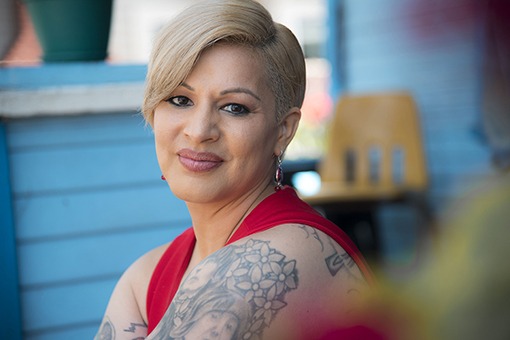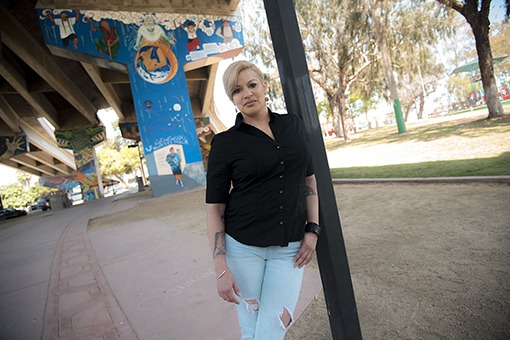At the age of five, my parents decided to get a divorce, and my home would quickly be separated. My mother moved to Logan Heights, a neighborhood known for its gangs and drugs. At an early age, I was not proud to call Logan my home. When people asked me where I lived, I’d make a vague statement like San Diego, hoping they wouldn’t ask for specifics, and if they did, I lowered my head in shame. However, as the years continued, I experienced Logan in a different light. I began dancing ballet folklorico and started performing at Chicano Park each year, the dances of Jalisco, Guerrero, and Veracruz. Chicano Park was established on April 22, 1970 when the city of San Diego was scheduled to build a highway patrol station on our land. But the people of Logan and other communities fought back by planting trees, blocking bulldozers, forming human chains, and painting the empty pillars that held up the Coronado bridge.
“...the funny thing about life is that it always has a way of bringing you back to where you belong.”

Chicano Park becomes part of my life
During my years in Logan, I made friends with Jamie and Choni, who lived across the street. I would go over their house every day to play any sport with a ball. Their mother, Nina Patti, would make us cheese quesadillas as she watched her favorite soap operas. Every Sunday, I would have to go to church to complete my classes for first communion. But as the Logan Heights community began growing inside me through the years, mother dropped the devastating news that we would need to move. I should have been happy because it was a better area of town, but truth be told, I didn’t want to leave.
As I got older and went to college, Logan became more distant inside me. I was busy completing deadlines for the semester and focusing on completing my degrees at San Diego State. Then once I was done with my education, my focus was towards teaching and coaching basketball. It’s easy to get caught up in the daily routines of life, but the funny thing about life is that it always has a way of bringing you back to where you belong.
“Every day during that summer, we painted from sunrise to sun down.”
The summer of 2012, Nayeli, Monse, and I painted a mural as part of the Chicano Park restoration project. We participated with the older women, who were the original muralists back in 1970 when Chicano Park had empty pillars that would soon emerge into Chicana creativity. Every day during that summer, we painted from sunrise to sun down. Our mural, called “Women Hold Up Half The Sky,” depicted strong Chicanas uniting to hold up the clouds as a symbol of strength for future Chicana generations.

Logan Heights Community unites against oppression
On September 3, 2017, word of mouth spread quickly that a group of white supremacists planned to deface the murals at Chicano Park because they were frantic that their Confederate statues were threatened to be removed throughout the U.S., and this was their proper recourse of action. The nationalists caused chaos in Charlottesville, Virginia causing a riot, killing a lady, and injuring other people of color who resisted injustice. The neo-Nazis attempted to create the same absurdity in mi barrio. The day the white supremacists strategized to eradicate the park they, too, were met with the same people, as well as the newer generation who raised up against oppression. Nayeli, born in Michoacán and majoring as an engineer at UCSD, wore her custom-made indigenous jewelry; Monse, born in Mexico City, who served in the U.S. Navy, wore her Mexican embroidered blouse; and me, la pocha, wore a t-shirt that read Desde La Logan in old English lettering. Each with our own unique barrio style, we met at ¡Salud!, a new taco spot that used to be the old Porkyland, where mother would send me each Saturday to purchase fresh maza tortillas. Most of the local businesses were replaced with businesses that generated more revenue geared towards modernization. The only thing that still remained authentic was Chicano Park.
Police officers were in full force, and the Chicano Park Steering Committee wrote a letter as a reminder to stand in solidarity and not display any form of violent acts. Over 500 people came together to protect the murals, forming a circle around each one. A native man blew on his ocean shell that warned us the Nazis had arrived. We quickly took our stance, fist in the air, like an army ready for battle. Nayeli, Monse, and I guarded our mural along with a group of Pachucos who traveled from Los Angeles to support the cause. There were different forms of Mexicans: the Pachucos, the rastas with dreads, the Zapatistas, the bikers, the homies in lowriders, the homegirls in Dickies, and the Brown Berets.
“Get out of our park!”
“We will fight back!”
“We are here to protect our indigenous land!”
“Afuera! Afuera! Leave! Leave!”
On this day, racism did not win. Flags from Mexico and other Latin American countries soared high. The Nazis were confronted by power and resistance. The police officers shielded the nationalists for protection but eventually escorted them off the premises, the crowd cheering in victory as they left. My uncle’s song played from the quiosco, “We shall continue to live my brother. We shall continue to fight my friend. For Chicano Park. Under the bridge.”
The day we stood up to white supremacists, Trump put a halt to DACA recipients. Nayeli was in the process of becoming a citizen through DACA. Her son was a US citizen, and I was torn that if she was removed from the only country she knew, her son would grow up without his mother. I realized the fight for our people wasn’t over.

Walking back to my car after the event settled down, I realized I had parked across the street from my old bus stop, which was in front of a two-story house, the same bus stop where I waited each morning to travel across town to go to school. Since the house I grew up in was only a block away, I cruised down memory lane. The house on Julian Ave. was no longer brown and yellow but blue with an American flag and Rottweiler guarding the property. An old man slowly approached the screen door when he noticed me loitering outside his property.
“Can I help you?”
“I grew up in this house.”
He thought for a minute, scratching his head,
“You’re Maria’s daughter.”
“Yes. She’s my mother.”
I explained that I was at the park for the protest and decided to come revisit my old house since I was in the neighborhood. I asked about Jaime and Choni. They moved out of Logan and up north starting their families, working their typical 9-to-5 jobs. Jaime was working for the city, and Choni, was a deputy.
The house, for the most part, was what I chose to remember. The cement steps leading up to the porch, the paradise flowers in the front yard, an apricot tree, and the driveway where I dribble my basketball. I pondered about growing up in Logan over the years. Some good; some bad. Although Logan was different in some aspects, I was still willing to protect my neighborhood even if I moved miles away.
As I stood outside my old house on Julian Ave, I was reminded that the little girl in me, once lost, now proud, found her way back home.
“...the little girl in me, once lost, now proud, found her way back home.”
Anti-Editor’s Note:
As we planned the content for our Ignite collection, it was important to me to look through the lens of igniting cultural pride. I reached out to a close friend at MANA to brainstorm Latina artists in the community that I might be able to profile. We talked about educators, historians, writers – Latinas in our community who ignite others in some way, shape or form that I might reach out to for an interview. Meanwhile, I decided I needed a break and some creative inspiration and went to one of my favorite events – So Say We All’s VAMP. Their monthly curated series features San Diego’s own storytellers baring their souls on the mic with true stories written from personal experiences interpreted from the provided theme – which happened to be ¡Vamonos! Every VAMP show I’ve attended brings a unique combination of perspective, laughs, tears and memories. But I knew as I listened to Vera speak that no profile I could write from some interview would compare with her own story of igniting cultural and community pride.
I reached out to Vera after the show, stalking her on Facebook, and sending emails through the show’s producers. Turns out, she’s a published author of two novels – Prison Letters: Walking to Honor, and Puto. Luckily, she agreed to share the written version in this month’s issue. We set up the styling and photography shoot and met up later that week. Our Founder, Arash Afshar, is fond of telling me the universe puts you where you need to be. I have not been to VAMP in almost a year, but I am certain the universe took me there to hear Vera’s story, so we could share it with you. As further evidence, we had one single mutual friend on Facebook – Rudy Gonzales, a former colleague of mine in Denver, CO who also happens to be the famed Rodolfo “Corky” Gonzlales’ son, and longtime civil rights activist in his own right. As Vera and I chatted, we talked about both knowing Rudy. I had to head back to my office, but as Vera, Adan and Arash walked through Chicano Park that afternoon for the photo shoot, who should they run into? Rudy, strolling through, admiring the murals, reminiscing.
Okay, universe. I hear you.
Revekka Balancier
Editor-in-Chief
